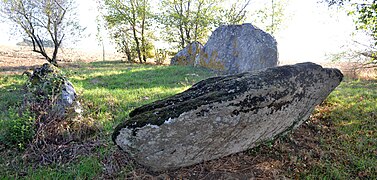Dolmen de Pierre-Folle (Thiré)
The Dolmen de Pierre-Folle is located east of Thiré in the Vendée department in France . In France, dolmen is the generic term for Neolithic megalithic structures of all kinds (see: French nomenclature ). The dolmen, built on a slope south of the Smagne River , was excavated from 1968 to 1971 by Pierre Chaigneau and Roger Joussaume and placed under a preservation order in 1968.
description
The rectangular chamber, bounded by seven orthostats , measures approximately 7.0 by 5.0 meters.
The orthostats are
- on the southwest side three bearing stones (No. I, II about 3.6 m long and 2.5 m high and VIII),
- the 5.6 m long end plate (No. III)
- on the northeast side two bearing stones (No. IV about 4.4 m long and No. V about 2.0 m long and 1 m thick in places),
- two bearing stones on the entrance side (No. VI and VII).
The estimated weights of bearing block No. II and the end plate are 10 t and 12 t, respectively. Orthostats IV and V barely rise above the ground and were probably shortened by rock- hammer at an unknown point in time . During the excavation, remnants of the originally complete tiled floor were found in the northwest corner and near the entrance.
- Dolmen de Pierre-Folle
The dolmen opens to the southeast. The shape and size of the chamber suggest that it is a "dolmen angevin". The discovery of two parallel trenches almost 4.0 m long and 1.0 m deep in the ground in front of the bearing stones No. VI and VII suggests the existence of an antechamber. In the vicinity of the entrance, part of the chamber was built with slates arranged on the edge. The presence of a post hole on the axis of the access (diameter 0.30 m, depth 0.33 m) means that there was a wooden facility. No trace of the tumulus was found.
All the stones used for the paving and the orthostats consist of two different types of gneiss . Since the local bedrock consists of limestone , this means that the stones have to be transported over a distance of around 6.5 km (from Les Humeaux to the east, where they were extracted).
The finds
The bones found correspond to about 40 individuals, most of which were found in the eastern part of the chamber. They come from several periods that include the Neolithic , Chalcolithic , Bronze Age, and later periods.
The 222 stone objects are supplemented by almost 800 more or less well-preserved quartz objects, as well as four arrowheads (one of the "Sublaines" type), graver and two slate plates .
The pottery finds include a barrel vase (“Pot-de-Fleur” type), a series of 17 bell-shaped vases and two cups decorated with cord.
The gold jewelry elements consist of seven rectangular plates, a disk and three tubular beads. A spiral copper ring.
The following bone jewelry was found: a tube with incised decoration, four V-perforated buttons, four pearls and an awl; stone jewelry : a limestone slab , ten variscite beads , three amber ornaments (two beads, one pendant) and a bowl.
literature
- Roger Joussaume: Dolmen angevin de Pierre-Folle à Thiré (Vendée). Étude architecturale et archéologique , In: Gallia préhistoire , Vol. 19, No. 1, 1976, pp. 1-38.
- Michel Gruet: Dolmen angevin de Pierre-Folle à Thiré (Vendée). Étude géologique , In: Gallia préhistoire , Vol. 19, No. 1, 1976, pp. 47-50.
- Thérèse Poulain: Dolmen angevin de Pierre-Folle à Thiré (Vendée). Étude de la faune , In: Gallia préhistoire , Vol. 19, No. 1, 1976, pp. 61-67.
Individual evidence
- ↑ The Dolmen angevin is an allée couverte of the Loire type with a (retracted) Trilith portal as access.
Web links
- Dolmen dit de La Pierre Folle in the Base Mérimée of the French Ministry of Culture (French)
Coordinates: 46 ° 33 ′ 9.1 ″ N , 0 ° 59 ′ 53.2 ″ W.




